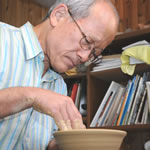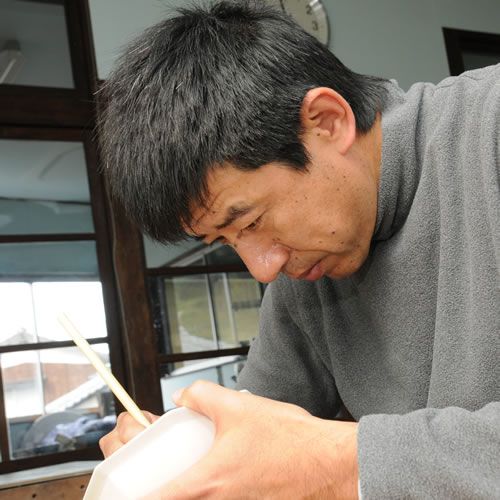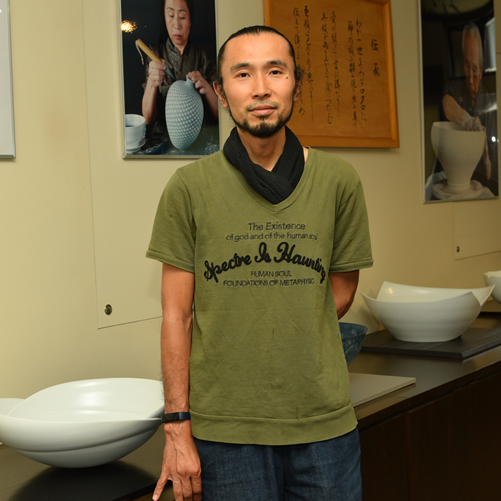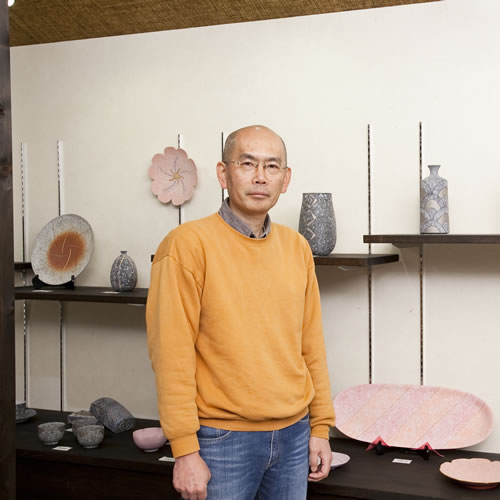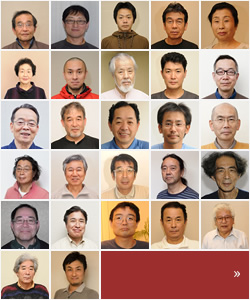TOP > Ceramics > Shigaraki Ware
Shigaraki Ware
It is made in Koga-shi, Shiga prefecture, the ceramic is simple and warm using the soil taken from the strata near Lake Biwa.
Shigaraki-yaki is produced in Shigaraki-cho, current Koka-shi, the southwest part of Shiga prefecture. It is counted as one of the six oldest kilns in Japan and is famous for the pottery village. Emperor Shomu started to build imperial Palace Shigaraki in the Tenpyo period (710 - 794 AD). He issued the imperial decree to construct the Great Buddha at the mid-Nara period and the capital had been located there for a few years. Remains were discovered and the largest building ruins were also found, people pay attention as an important base of the ancient history. Soil is flowing out of the mountains near Lake Biwa and it has been accumulated. The soil is fitted for making ceramics. Firewood are also able to be obtained abundantly, the conditions of producing yakimono are satisfied and shigaraki-yaki has been carefully brought up to the present.
Back to Kamakura period about the Shigaraki-yaki history, Tokoname potters helped Shigaraki men to horn the skill. When it was Sengoku the warring states period, tea people extolled the texture just then due to tea utensils boom. New style of ceramics were made in various places in half of the 14th century, instead of Tokoname ware which had gradually less produced. There are molding method in Shigaraki ware like himozukuri, wazumi seikei forming with coils and kakiage. Like middle ages old kilns, potters often made tsubo (jar), kame (large pot), and suribachi (mortar) against the background of agricultural development. They were sometimes used as bone organ, not only as farm tools. However, they weren't distributed nationwide and were remained in the surrounding area. Then a little red brown color called "hiiro" was seen and modern tint like "haikaburi" (covered with ashes) and "bidoro-yu" (vidro glaze) became known.
Literature says that Shigaraki pottery is often used for tea ceremonies due to tea utensils boom. Our tea ceremony started from karamono (item that came from China), people slowly looked tableware as vase or water jar such as Bizenyaki or Shigarakiyaki and they were used such items as tea utensils. Then MURATA, Juko who was the tea master, TAKENO, Jo-o and his apprentice Sennorikyu and others had been succeeded the culture. Tea masters found Japanese senses of beauty "wabi-sabi from simplicity" in Shigaraki-yaki. People associated with the shape of the vessel and named it. There is a tube-shaped small jar called "tabimakura-hanaike", it was named because the shape resembles a portable pillow. And people originally used small vase called "uzukumaru-hanaike" with small mouth and a bit distorted body. It looks like a person is crouching (uzukumaru means crouch in Japanese).
In Edo period, potters made various type of tableware with high-quality soils. OGAWA, Tokusai who was active in the end of Edo period was known as Iga-yaki master. There are artists who had played an active part in Shigaraki, such as TATSUNAMI, Monzaemon, TANII, Naokata, Shinkaizan and OKUDA, Sanraku. The most popular artist, KITAOJI, Rosanjin used soils taken in Shigaraki. Then, the third generation potter TAKAHASHI, Rakusai and the fourth potter UEDA, Naokata made an effort to reconstruct of Ko-shigaraki and produced original ceramics in Showa period. Shigaraki-yaki generally reminds people of the racoon figurine. It is nationally famous and we can see them in front of the shops. Once they were produced in other areas, the first generation potter of Rian had appeared in the early period of Showa and his ornaments were so expressive that they were sold a lot. When Emperor Showa traveled to Shigaraki, the dolls of racoon dog with hinomaru national flag of Japan met them. Then people like having it asa lucky charm. It is charming and is appropriate to any place.
Almost ceramic artists are fond of making their own Shigaraki rather than sticking to the tradition.
The technique of Shigaraki Ware
Hiiro (fire marks)
Soils taken in Shigaraki have less iron and they react by firing such as salt, water and ash. Clay is colored with red lightly.
Higakimon (pattern)
The pattern engraved on the shoulder is characteristic of old Shigaraki ware things like successive X marks carved in the double lines, arrow feather shapes pattern.
Haikaburi (covered with ashes)
Putting ceramics near the door of the kiln, a pattern expresses spontaneously because the ashes of firewood are poured on the ceramic.
Bidoro-yu (vidro glaze)
The ashes of firewood are melted with feldspar together. It becomes the glaze in the nature of the glass and flows out.
Tonbonome (the eye of dragonfly)
A line by melted natural glaze flows out and collects hemispherically. Many people are fond of seeing the scene in the tea ceremony.
Ishihaze (crack pattern by burst stone)
Stones are burst by firing.
Koge (black color by buried in ashes)
It is further burned and becomes black at the high temperature.
Kuttsuki (special pattern)
The pattern that the next ceramic falls down, touches and other debris sticks with when they are firing. Especially, the pattern is the scene in the vase or the jar. This is the yakishime (high-fired pottery) -specific design.

